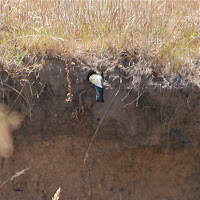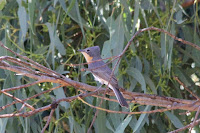The air is full of birdsong at Swinging Bridge Reserve, Wee Jasper. "Song" is not always apt when much of the "noise" is coming from the large parrot population. Sulphur-crested cockatoo, King parrots, Crimson rosella and Galah were the most obvious during our visit last week. Yellow-tailed black cockatoo and Gang-gang (although not seen on this occasion) are also regular visitors.
 |
| Australian King parrot (male above, immature below) |
 |
| Immature Crimson rosella |
 |
| Rufous whistler were actively singing .... err ... whistling! A constant joy! |
 |
| The penetrating piping of White-throated treecreeper added some further charm. |
 |
| Yellow-faced honeyeater was the predominant honeyeater species and leant its frequent brisk call to the chorus. |
 |
| My first thought was that this was an immature Black-chinned honeyeater but it has been pointed out that Brown-headed honeyeater is a much better fit - Excellent - a lifer! A review of Pizzey suggests that there are five honeyeater species with that familiar white nape and paler front. Of these I am yet to see the Strong-billed honeyeater endemic to Tasmania. |
The Leaden flycatcher buzzing calls added a different dimension as did the
Satin bowerbirds at their bower. Noisy friarbird were ..... well, noisy! Kookaburras provided a daily (or twice daily) chorus. When I first heard roosting Australian wood ducks calling ("gnaaaaw") I wondered if I was listening to a broken kookaburra that couldn't get going!
 |
| Australian wood duck - We don't really "quack" |
Large numbers of Superb fairywren led the small bird voice accompanied by White-browed scrubwren. Diamond firetail provided an occaisonal finchy flavour.
All in all a most pleasant and amazing soundscape!
Bird on!































































